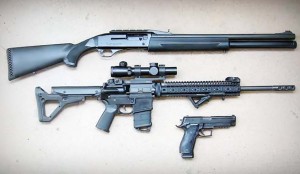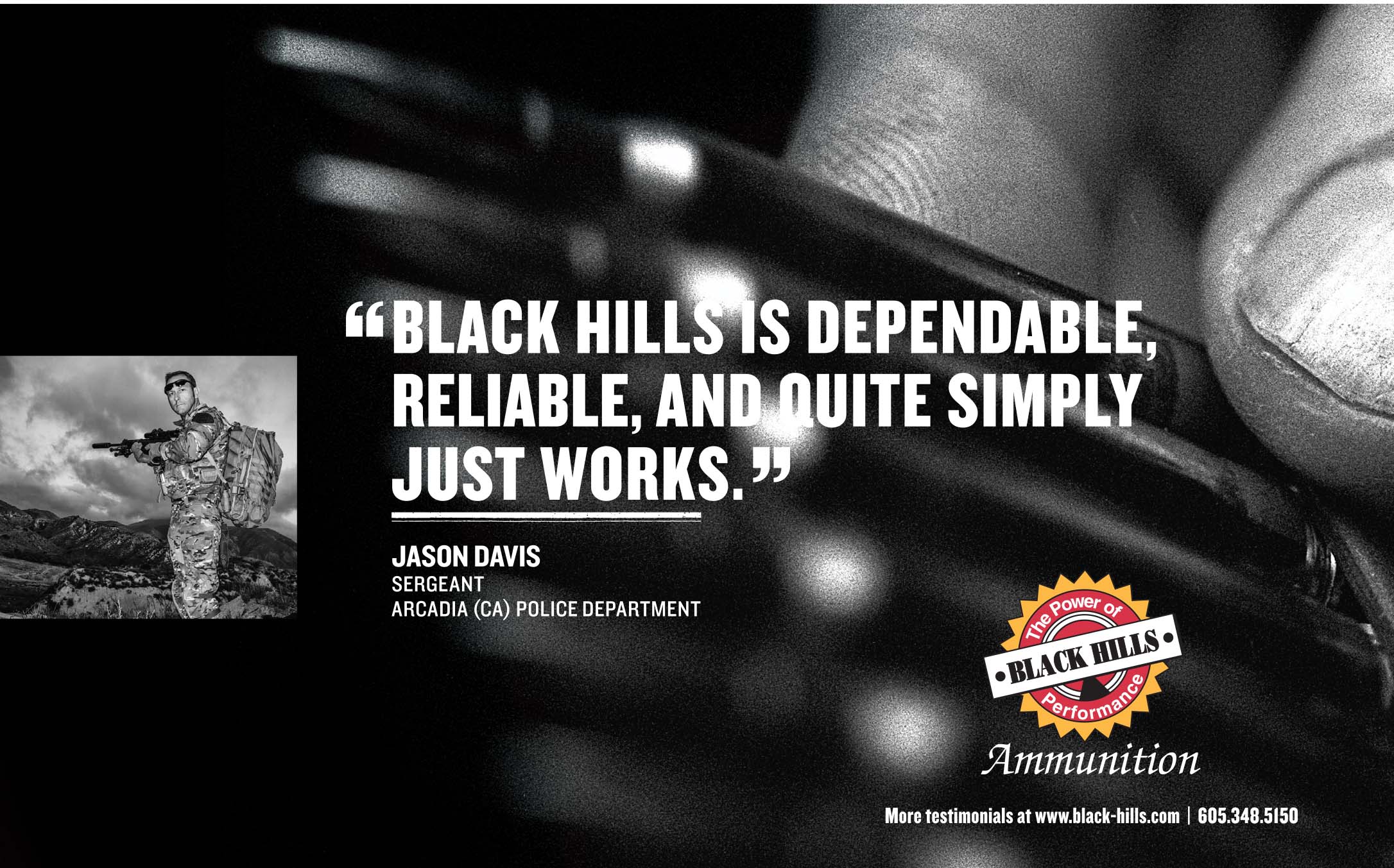by Scott Smith | Contributing Editor
I have been competing in action shooting sports for 20-plus years. Over that time I have competed in USPSA, IDPA 3-Gun, bowling pin and PPC matches. All of these matches are fun and enhance various shooting skills. One thing I have noticed with all of these competitions is the perceived need to rush out and buy the “best” custom firearms so you are competitive.
During the years I have competed, I have owned several expensive custom built pistols including a couple of U.S.P.S.A. open class pistols with all the bells and whistles. What I found with these thoroughbred race pistols and ARs is that all are picky and require custom loads to make them perform consistently. You have to tailor your loads to perform with the reduced spring rates, lightened bolt carrier groups and slides. I do not have the patience to invest the time required to tweak each and every load of each firearm so that it will run. I also am not anal retentive when it comes to maintaining my firearms to ensure they function properly with their tight custom tolerances.
What I have learned over the last two decades is spending hours to develop loads or tons of money on the next best custom firearm is that I cannot purchase better times and more “A’s”. With my well over-50 eyes and beat up ole GI body I cannot move fast enough to reduce time moving between shooting arrays and all the new gadgets available will not make me a better shooter. What I do benefit from is having firearms that fit my needs, function properly and that I am intimately familiar with their functioning. This is why I started using firearms from my vault that have proven to be reliable no matter the weather, how dirty they are or how old they are. Instead of buying new firearms I upgraded and modified the ones I have to fit the competition—be it IDPA, USPSA or for 3-Gun. Let’s take a look at what I did and what you can do to make some firearms more competition worthy. Since some folks will ask: Yes, the firearms in the article are mine, they are not loaners. Each has been Duracoated in various camouflage patterns to set them apart from others and to protect them from the elements.
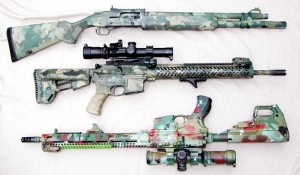
Author’s 3-Gun long guns: top is a lightly customized Mossberg 930 Blackwater/SPX, middle is Stag Arms 3G with Burris optics, bottom is the custom rebuilt Ruger AR556 with Weaver Kaspa scope.
Shotguns
When shooting 3-Gun, you need a solid shotgun that is capable of accurately shooting slugs, buckshot and birdshot. If you have a Mossberg 590 or Remington 870, you can use it. Heck, I saw a piece online of a guy using a Stoeger side-by-side coach gun. While they are “slower,” pump shotguns will function with any load. If my 870 had not been ported as part of a Vang Comp rebuild, I would use it. However, the porting is only allowed in unlimited/open division. The only other shotgun I own is a Mossberg 930 (Phone: 203-230-5300). With competition being about fast shooting, this well used 930 Blackwater model (now the SPX) is a good gun. This was the first gas-operated shotgun I have used extensively that ran on virtually everything fed through it from the inexpensive bulk packs to high end trap/skeet loads to slugs of all types. Other factor standard options on the 930 BW/SPX are an extended magazine tube, ghost ring sight and fiber optic sight. It was a solid gun for training classes. These options make a good 3-Gun shotgun. I did not like the pistol grip butt stock, so I purchased a traditional straight type stock.
While it was ideal for previous applications, it had shortcomings for competition. The 930 lacked the ability to accept choke tubes and the magazine capacity needed increasing. Instead of purchasing a new shotgun I sent the barrel to Aimpro Tactical (Phone: 800-399-1354) to have it threaded for choke tubes which cost $70 and I procured an extended magazine tube from Nordic Components (Phone: 952-442-8908) MXT mag tube for $79.95 and barrel clamp for $31.95. With these additions on its first outing the 930 ran flawlessly at the Brownells/Rockcastle Pro-Am and still does.
Numerous trips to the range verified that when using a full or improved modified choke tube the 930 is capable of knocking down steel with buckshot at distances out to 40 yards, and quickly cleans clay birds mounted in ground supports or breaks them in flight. When needed, a modified or IC tube allows the 930 to put five slugs into the “A” zone at distances of 50 yards or more.
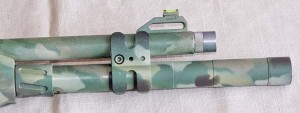
Close up of the choke tubes threaded by AimPro Tactical and magazine extension from Nordic Products.
If you do not have the 930 BW or other shotgun to use in 3-Gun, there are affordable options that will get you in the game for under $800. Because of my experience with the Mossberg family of shotguns, the 930 JM Pro with 22” barrel, nine-shot magazine and fiber optic bead would be my first choice. For $776 you can run the shotgun the Miculek family shoots (the “JM” stands for Jerry Miculek).
Another affordable semi-auto shotgun is Stoeger’s new M3K3. The M3K3 is purpose built to be an affordable 3-Gun shotgun. With a retail of $699, it ships with interchangeable chokes, extended controls, fiber optic bead, and the loading port is opened for easy loading and uses Benelli’s proven inertia drive. All you need is to add a magazine extension and the M3K3 is ready to run; many 3Gun Nation pros are now running it. You can find details on the M3K3 at stoegerindustries.com.
Rifles/Carbines
The other long gun in use in 3-Gun competition is a rifle/carbine with the Modern Sporting Rifle, M4/AR15, being the dominant platform. It is really easy to spend a ton of money to have the “perfect” 3-Gun carbine. Like you, I have read various publications with most “guns of choice” having prices at $2000+. This is a lot of money to get started; fear not there are affordable factory firearms on the market. It’s hard to beat Stag Arms (Phone: 860-229-9994) and the solid reliable carbines they build. Stag Arms’ 3G model is built for competition with an MSRP of $1459. This MSR’s standard features are: an 18”, 1 in 8” twist, fluted barrel fitted with Stag’s 3G compensator; Magpul ACS buttstock; Samson 15” Evolution forearm, and Geissele 3G 3.5lb trigger. It weighs in at 7.8lbs. The buttstock, trigger and forearm would set you back roughly $600 to add to any MSR, making the 3G a true value packed rifle.
The only modification I made was the pistol grip from the MOE to a Command Arms UPG16 (Phone: 215-949-9944) with an MSRP of $36.75. The MOE grip does not feel right to me. I did invest in good optics. A Burris’ XTR 1.5-8 on a PEPR purchased at Brownells (Phone: 800-741-0015) will set you back $1149. The Stag/Burris combination will easily shoot MOA at 230 yards (maximum distance my range has) all day long and had no problem engaging steel swingers at 300 yards shooting the Rockcastle/Brownells Pro/Am last year. When it comes to accuracy and overall performance, I have found this combination to show no preference for bullet weight or manufacturer.
If you prefer a shorter MSR, Stag offers the 3T-M, a 16” 1 in 9” twist barrel gas-system firearm with a Magpul ACS buttstock, 13.5” Diamondhead VRS-T free float forearm and Diamondhead flip-up sights. With its $1,160 retail price ($600 of which is the upgrades), I would consider adding a better trigger to enhance the 3T-M’s accuracy. Stag will install a 2-stage 2.5/3Lb match trigger for $90 or a Geissele S3G for $240, which is essentially the cost of the trigger. When testing the 3T-M, thanks to the Diamondhead, diamond-shaped aperture, even with my old eyes I could shoot 4” groups at 100 yards. Not surprisingly, when I installed a Weaver Kaspa scope on the rifle, groups consistently hovered at 1½” no matter the load.
For those who would prefer an affordable M4 style carbine without the bells and whistles, the Ruger (Phone: 336-949-5200) AR556 with its $749 price tag is hard to beat. The AR556’s standard features are an adjustable stock, flip up rear sight, Magpul magazine and, most importantly, the 1 in 8” twist medium contour barrel with Ruger’s flash suppressor. Out of the box, this is one of the most accurate rifles I have tested and its reliability is all Ruger.
These three Modern Sporting Rifles will get you started and be competitive in 3-Gun matches. All you need is optics and you will be ready to compete. I have run hundreds of rounds through Stag’s 3G, 3T-M and Ruger’s AR556. They all perform flawlessly, have MOA or better accuracy and are capable of being used for action shooting out of the box. My 3G and 3T-M, save for being finished with Duracoat, have remained stock. Ruger’s AR556 with its solid bones was used as a base gun to build a custom MSR for TheGunMag’s annual AR Accessories Issue. The advantage of using a solid carbine like the AR556 to build a custom MSR is you can do it in steps as funds allow and you can choose the parts you like. TheGunMag has done in-depth reviews of all three of these rifles (Stag 3G, July2015); Stag3T-M, (July 2014); Ruger AR556, (Feb. 2015 and July 2015).
Handguns
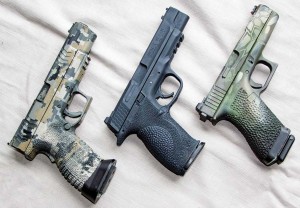
Solid pistol choices to get into 3-Gun: left to right, Springfield Armory XDm 5.25, Smith&Wesson M&P Pro 9L and a 20-year-old Glock 17.
The last firearm you need for 3-Gun and for shooting U.S.P.S.A. and I.D.P.A. is the handgun. If you watch 3Gun Nation, you will find the dominant pistols are the highly customized 1911, Glock 34/35s (Phone: 770- 432 -1202), Smith&Wesson M&Ps (Phone: 800-331-0852) and numerous other full house custom pistols generally in 9mm because there is no power factor. Fear not, you do not have to wait a couple of years and tie up thousands of dollars to have a truly competitive pistol. An out of the box Smith & Wesson M&P Pro9, Glock 17/34 or a Springfield Armory XDm (Phone: 800-680-6866) will make you competitive. So will any number of double-stack 9mm pistols.
Smith & Wesson’s M&P9 Pro, is a practically perfect out of the box competition pistol. This pistol was built with the input of Smith & Wesson’s Shooting Team and built to be match ready. The Pro ships with a Novak rear sight and fiber optic front sight, interchangeable grips for fit, and a good trigger and retails for $689. When I took my test M&P 9 Pro I consistently shot sub-3” groups at 25 yards with a wide variety of ammunition. It was used out-of-the-box to shoot several local U.S.P.S.A. and was flawless. You will see a future article on turning this into a home built custom pistol, that’s how much I like it.
Springfield Armory is known for 1911s and M1As for competition, but is now developing a huge following of the polymer XDm for competition. I found my XDm to have one of the best triggers of any polymer pistol. With a fully adjustable rear sight, fiber optic front, interchangeable back straps and crisp, short resetting trigger, the XDm is competition ready. To enhance the XDm for me I stippled the frame and added a $65 Pistol Gear (Phone: 405-252-0936) Operator Magwell. The magwell was not added for my blinding reloads but to aid with a consistent high grip. My XDm 40S&W has been used in dozens of matches, with thousands of rounds fired through it and has never malfunctioned. Aside from the grip being stippled, the Pistol Gear Operator Magwell being added and refinishing it with Duracoat, no work has been done to this pistol; it is just that well designed. The XDm ships with three magazines, a holster and mag pouch; retail price is $739.99.
If you are going to use a G17/34 for competition, they will set you back $729.99 and need very minor enhancements to be match ready.
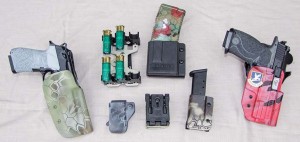
This is an array of holsters, magazines and shotshell carriers from Blade-Tech, Comp-Tac and Invictus Practical. Over the years this gear has proven to be indestructible.
Those enhancements are the sights and trigger on the G17 and just the sights of the G34. Glock’s front sight is big and boxy, making accuracy at distance challenging. Personally I added sights from 10-8 Performance to my 20-year-old G17, because I like the U-notch rear with the red fiber optic front. A less expensive option is to blacken the white outline of the rear and add a fiber optic front, which will vastly improve speed and accuracy. On a G17 another cheap and easy improvement is to install a 3.5lb connector which is standard on the G34. You will notice the difference immediately. These three parts will set you back less than $100, after that the sky is the limit. If you plan to shoot lead bullets, install an aftermarket barrel. The polygonal rifling in Glock barrels has been known to “lead-up” with catastrophic results. It is well worth spending the $140-160 not to have a kaboom happen.
The area you can spend vast sums of money for competition is on the accessories; namely the belt, holster, magazine pouches and shotgun shell carriers. When you look at a belt, do not skimp on it; your gear will shift and you will never be happy. You will find two of the best, most cost effective belts on the market are Blade-Tech’s Competition Belt and CR Speed at Brownells. Both of these are complete inner and outer belt systems and are popular with 3-Gun and USPSA shooters. Holsters and gear designed for competition or equipped with Tek-Loks easily attach to these belts. These belts will set you back approximately $65 and are worth every penny.
Next you need to securely carry your handgun, for this I again suggest Blade Tech or Comp Tac. These two manufacturers offer traditional style holsters to accommodate most of the popular pistols used in competition today. Their holsters are secure, fast, virtually indestructible and competitively priced; holsters will set you back $65-$75 and magazine carriers for MSRs and pistols will cost on average $25-$75
To carry your shot shells, I suggest carriers from Invictus Practical , Carbon Arms and AP Industries (both available at Brownells). These carriers use the two by two, quad loads carrying four to sixteen shells. The Carbon Arms 6 Round Pinwheel, as the name implies, holds six rounds, mounts with a Tek-Lok and will set you back $71.99. AP Industries ships standard with Tek-Loks and vary in price from $49.99-$99.99. Invictus Practical offers a number of carrier options ranging in price from $69-$119.50 plus mounting bracket. Tek-Loks are an additional $12. All are hugely popular shell carriers and will serve you well, but you will need to do some research to see what best suits your needs.
I realize this was a brief overview of firearms and gear for 3-Gun competition, but to cover the vast array of firearms and gear, we would need to publish a novel. You will notice most of the gear is stock, nearly stock gear or has modifications you can do in steps and still be competitive. What competition shooting boils down to is: If you have a reliable rifle, shotgun and handgun with a good holster, magazine carriers and shotshell carriers you can go shoot. Over the last couple of years I have talked with local match directors who tell me of folks at matches with Model 94s in .357 mag or 30.30, using their 870 with 26” barrel they used to hunt with and handguns of all makes. The important thing is to get out and shoot at your local club. I suggest checking out 3gunnation.com, it is the source for information on matches and gear; of course Youtube is also an invaluable asset. Have a great summer, get out and shoot safe, shoot straight and have fun.

